Dissecting an unusual case of stomatitis
Medical management is possible, but often these cases result in extractions.
The dental case in the November issue demonstrated severe stomatitis complicated by erythema multiforme in a dog. As promised, this case will show generalized ulceration and stomatitis from a slightly different perspective.
A 5-year-old spayed female pug presented with purulent discharge and halitosis of several days' duration. The patient would not allow visual examination of the oral cavity, demonstrating violent avoidance of head manipulation. A CBC, chemistry profile and urinalysis were performed. Mild hyperproteinemia and neutrophilia were present. Under general anesthesia, visualization of the extent of the oral disease could readily be appreciated. Marked mucopurulent oral discharge was present (Photo 1). Severe malodor, oral ulceration and erythema were also present (Photo 2). The lateral surface of the tongue and any point of tissue contact with the tooth surface were similarly affected (Photo 3).
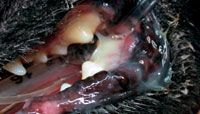
Photo 1: Mucopurulent oral discharge is evident in this 5-year-old pug.
So what appears to be different in this presentation versus the stomatitis case presented in November? Note the focal distribution of the lesions in this case compared to the generalized involvement of the entire oral mucosa. Pain is severe, and it's evidenced by the violent avoidance behavior compared to the mild response to manipulation in the previous case. The purulent discharge is also more severe. Based on the lesion distribution, this case represents a recognized clinical entity, classified as chronic ulcerative paradental stomatitis. It's the most likely rule-out, though other entities should be considered. This condition is characterized by tissue ulceration and stomatitis on the oral mucosa that contacts the teeth. Due to the severity of the disease and the pain involved, aggressive management is paramount. Biopsies should be done to rule out other causes of stomatitis and oral ulceration.
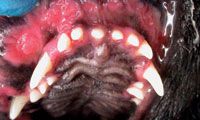
Photo 2: Oral ulceration and stomatitis are evident in regions where tissue contacts the tooth surface.
What would you discuss with the owner at this point? What is the prognosis and what management options exist? Pet owners will want to know the cause of this dental condition.
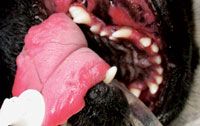
Photo 3: The lateral margins of the tongue are affected where contact with the mandibular teeth occurs.
Individual patient intolerance to plaque is evidenced by the intense inflammatory reaction to any tissue coming in contact with the plaque-retaining tooth. The organisms within the plaque biofilm are not the target of therapy, however. Although tissue destruction is modified somewhat by systemic antibiotics, they are not effective long term because they do not penetrate the biofilm. The biofilm itself and the host's response to it are the targets of therapy in these cases.
Pet owners must realize that this condition is extremely management intensive, and it requires lifelong dedication to a very strict regimen if a non-surgical approach is chosen. Options for conservative management are similar to those discussed in November. (Go to dvm360.com/dentistry.) Unfortunately, the prognosis for effective long-term management is poor. This is due to a combination of the intense host-immune response in these patients and a lack of compliance with aggressive home care and in-hospital prophylaxis requirements.
An initial dental cleaning followed by aggressive home care including daily brushing, chlorhexidine gel, anti-plaque water additives, dental chews and diets are required to mechanically and chemically alter the biofilm. Opiates should be used initially for analgesia. Unfortunately, most patients require immunosuppression initially, possibly long term, to provide adequate relief from pain to allow oral manipulation. Prednisone alone or in combination with azathioprine is required. Systemic cyclosporine has been used with some success. Prophylactic cleanings in the hospital are required every three to six months — and in some cases more frequently.
In this particular patient, in-hospital prophylactic dental cleanings, immunosuppressive prednisone and home care were ineffective at providing an adequate response. Six weeks following discharge, the patient returned with similar severity. The owner could not provide home care after lack of patient response following tapering doses of prednisone.
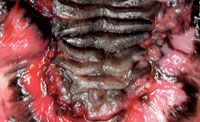
Photo 4: The maxillary mucosa demonstrates the difference between the first and second extraction sequence. Note the partial resolution of the patient's right Âmaxillary arcade (right side of image).
Initial discussions with pet owners should include the recommendation for a surgical approach. Extraction of teeth adjacent to CUPS lesions often is the ultimate therapy for these patients and, in our experience, curative. Involvement of tissue adjacent to all teeth in this patient necessitated full-mouth extractions. Due to an uncontrollable hypothermia, two procedures were necessary to complete the extractions in this patient. An immediate postoperative image shows the early response from the previous extractions performed 10 days prior (Photo 4). Local nerve blocks, analgesic CRI and postoperative opiates, NSAIDS and gabapentin provided excellent analgesia. Keep in mind, aggressive pain management is paramount.
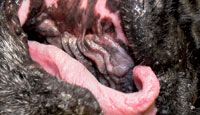
Photo 5: Complete resolution is evident in this image taken six weeks following the second extraction sequence.
An image taken six weeks postoperatively shows a complete response to the extractions (Photo 5). Not all cases require complete extractions, however. Another patient suffered from CUPS lesions adjacent to the maxillary canines. Extraction of those two teeth resulted in complete resolution (Photo 6).
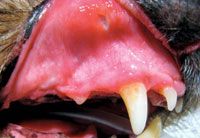
Photo 6: A single lesion is present in the alveolar mucosa adjacent to the maxillary canine tooth. The right side had an identical lesion.
Although this particular case was strongly suggestive, differential diagnoses in patients with CUPS should include other causes of oral ulceration: immune-mediated disease, infectious disease, uremia and neoplasia. Aggressive medical or surgical management combined with analgesic therapy is the only hope for patients with this disease. A wait-and-see approach to treatment is not an option.
Brett Beckman, DVM, Dipl. ACVD, Dipl. AAPM
Dr. Beckman is past president of the American Veterinary Dental Society and owns and operates a companion-animal and referral dentistry and oral surgery practice in Punta Gorda, Fla. He sees referrals at Affiliated Veterinary Specialists in Orlando and at Georgia Veterinary Specialists in Atlanta; lectures internationally; and operates the Veterinary Dental Education Center in Punta Gorda.